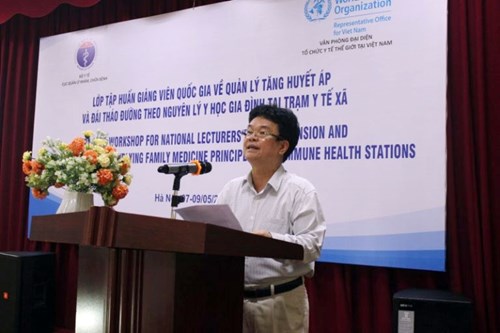May 08, 2018 | 23:04 (GMT+7)
Training course on high blood pressure, diabetes management opens
The Vietnam National Administration of Medical Services and the World Health Organisation (WHO) in Vietnam opened a training course in Hanoi on May 7 for lecturers majoring in high blood pressure and diabetes management in communal medical stations.
Speaking at the event, Deputy Health Minister Assoc. Prof Pham Le Tuan said under Resolution No.20-NQ/TW dated October 25, 2017 by the Party Central Committee on the protection, care and improvement of public health in the new situation, 95 percent of medical stations in wards, communes and townships will prevent, manage and treat several non-communicable diseases by 2025 and the rate will reach 100 percent by 2030.
    |
 |
|
Deputy Health Minister Assoc. Prof Pham Le Tuan speaking at the event. (Photo: kcb.vn) |
Earlier, the Prime Minister approved Decision No.376/QD-TTg dated March 20, 2015 on the national strategy on preventing non-communicable diseases for the 2015-2025 period and Decision No.2348/QD-TTg dated December 5, 2016 on strengthening health care at the grassroots level.
WHO chief representative in Vietnam Kidong Park said high blood pressure and diabetes, which could be easily diagnosed and treated at grassroots medical stations, are the most important risks of cardiovascular and non-communicable diseases in Vietnam and the world.
Participants discussed early diagnosis, treatment and management of high blood pressure and diabetes, nutrition and physical activities in the field, family medicine principles in management, common guidelines on prevention and management of non-communicable diseases at grassroots medical stations, among others.
Statistics in 2015 showed that only 43.1 percent of high blood pressure patients were diagnosed and 13.6 percent were treated in medical stations. Meanwhile, 31.1 percent of diabetes patients and 28.9 percent were diagnosed and treated, respectively.
Source: VNA